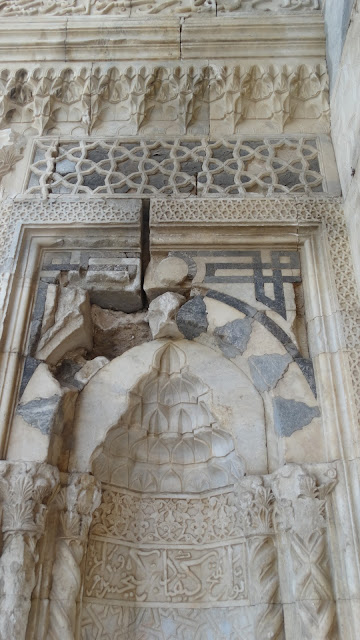Caravanserai - Sultanhani
 |
| https://www.tripadvisor.de/Tourism-g8022292-Sultanhani_Aksaray_Province-Vacations.html |
I saw this peculiar structure in the middle of a desert in a small village while driving from the airport at Nevsehir to Konya in south-central Turkey. I was in the early stages of making a large 2-day circuit with my rental car before attending a professional conference, visiting several cities which the Apostle Paul had visited.
Viewing it from from a distance, I decided to make a short visit and investigate. It wasn't exactly a fortress nor a castle. Instead, it was an inn with stone walls, a caravanserai,(caer-a-van'-ser-ei). These complexes had served a very special function in parts of the world where there had been ancient trade routes.
 |
| https://www.imageprofessionals.com/en/images/70293332-Camel-Caravan-in-the-libyan-desert-Dromedaries-Camelus-dromedarius-Akakus-mountains-Libya-Sahara-North-Africa |
Caravanserais are large fortified structures that housed and protected traveling merchants, their caravan animals and their camel drivers who traversed the Silk Road in previous centuries of the Middle Ages, assisting travelers who were navigating routes between China, Turkey and the Mediterranean region.
Map of the routes of the Silk Road.
 |
| https://en.wikipedia.org/wiki/Camel_train#/media/File:Salt_transport_by_a_camel_train_on_Lake_Assale_(Karum)_in_Ethiopia.jpg |
 |
| Izadkhast caravanserai (early 17th century), Fars Province, Iran - Wikipedia |
Can you imagine trying to spend countless nights in the hostile world of the desert on a journey lasting several months with your camel train? Dangers would come in the form of enemy armies, robbers, wild animals, dust storms, incessant wind, hot and cold temperatures, rain and snow, lack of water and food.
 |
| https://www.prints-online.com/new-images-august-2021/egypt-halt-camel-train-desert-23448624.html#modalClose |
They also provided an opportunity for merchants and other travelers to exchange goods, access local markets and interact with people from different cultures across the vast stretches of the Silk Road.
https://www.youtube.com/watch?v=JSucjTybSfk
By offering such an intercultural environment, caravanserai were important sites for the exchange of cultural values, languages and ideas. Marco Polo was the most famous traveler to use the Silk Roads.
 |
| Shah-Abbasi Caravansarai in Karaj, Iran - Wikipedia |
Silk Roads in Anatolia
Anatolia - the area of modern Turkey - has served as a bridge between the East Asia and Western Europe since ancient times. During the Middle Ages, a large number of roads used by the Silk Road stretched between numerous cities; from Central Asia to Antalya, to the Aegean coast the ports of Ephesus and Miletus, the ports of Trabzon and Sinop in the Black Sea Region, Istanbul in the north-central region, and the Mediterranean ports of Alanya and Antalya in the south. Sea routes were often part of the main route used to reach Europe.
 |
| https://ontheworldmap.com/turkey/large-detailed-road-map-of-turkey.jpg |
Sultanhani is located on the road between Aksaray and Konya
A detailed listing of Caravanserai in Turkey:
The Silk Road in Anatolia:
In the North: Trabzon, Gümüşhane, Erzurum, Sivas, Tokat, Amasya, Kastamonu, Adapazarı, Izmit, Istanbul and Edirne;
In the South: Mardin, Diyarbakır, Adıyaman, Malatya, Kahramanmaraş, Kayseri, Nevşehir, Aksaray, Konya, Isparta, Denizli, Antalya are the centers passed by.
In general, the following sites in Turkey also have Seljuk caravanserais: Erzurum, Malatya, Kayseri, Ankara, Bilecik, Bursa, İznik, İzmit, and İstanbul.
In order to promote commercial trade in Anatolia, Seljuks provided security by building caravanserais on roads connecting these cities..
Following are some pictures that I took - along with one from another visitor - at the Sultanhani Caravanserai.
 |
| cliff_emerson |
 |
| cliff_emerson |
 |
| cliff_emerson |
 |
| cliff_emerson |
 |
| cliff_emerson |
 |
| cliff_emerson |
 |
| cliff_emerson |
 |
| cliff_emerson |
 |
| cliff_emerson |








